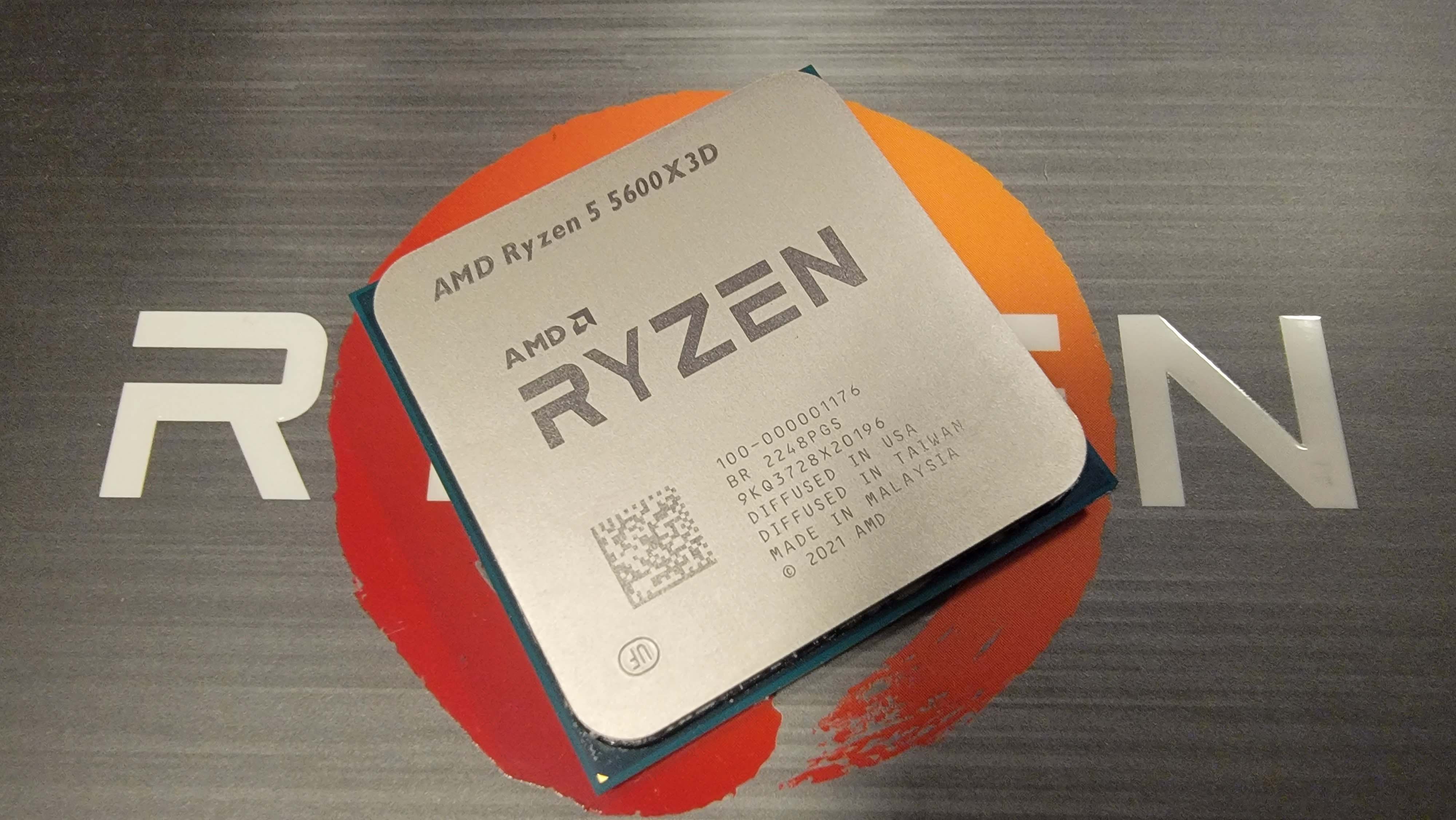Why you can trust Tom's Hardware
AMD Ryzen 5 5600X3D Power Consumption and Efficiency
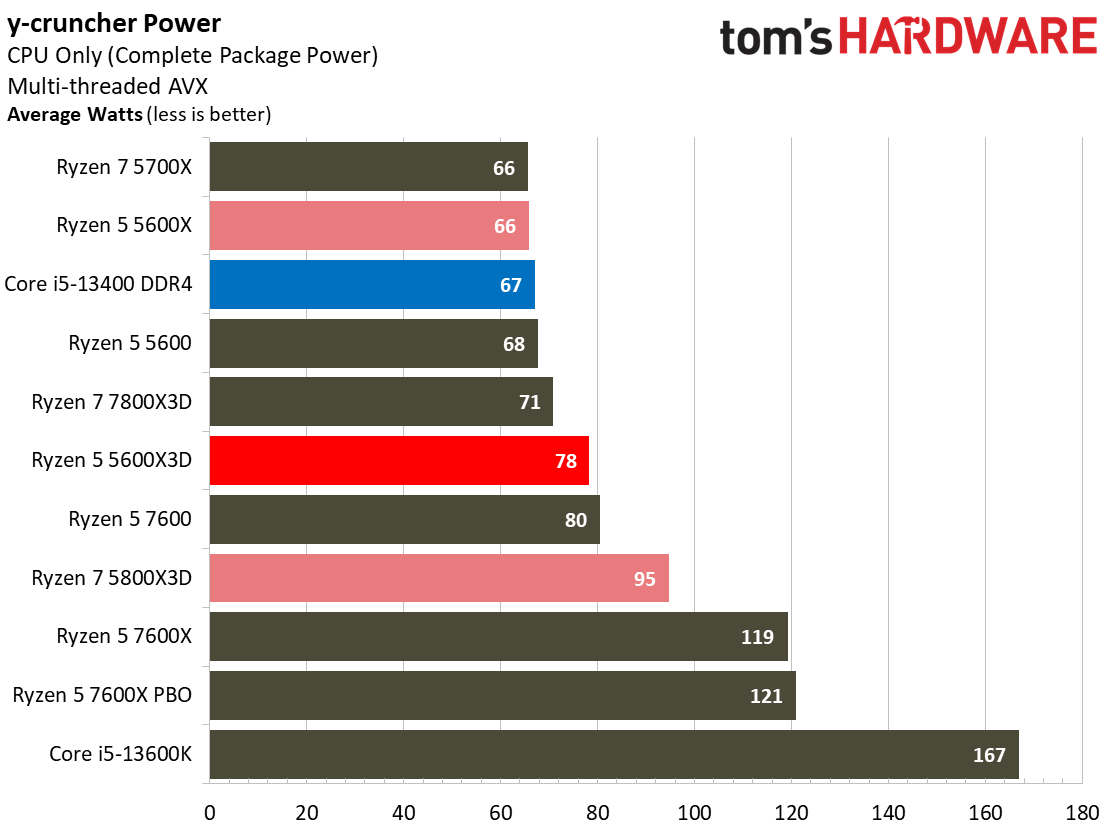
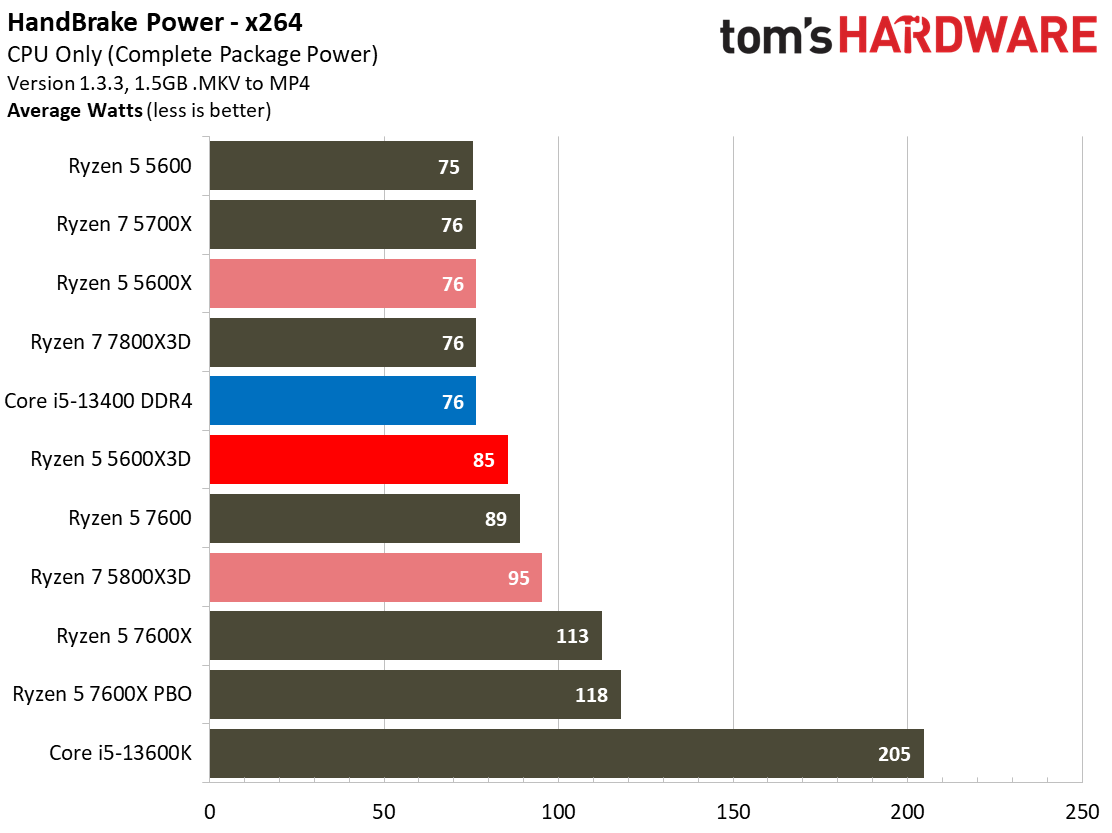
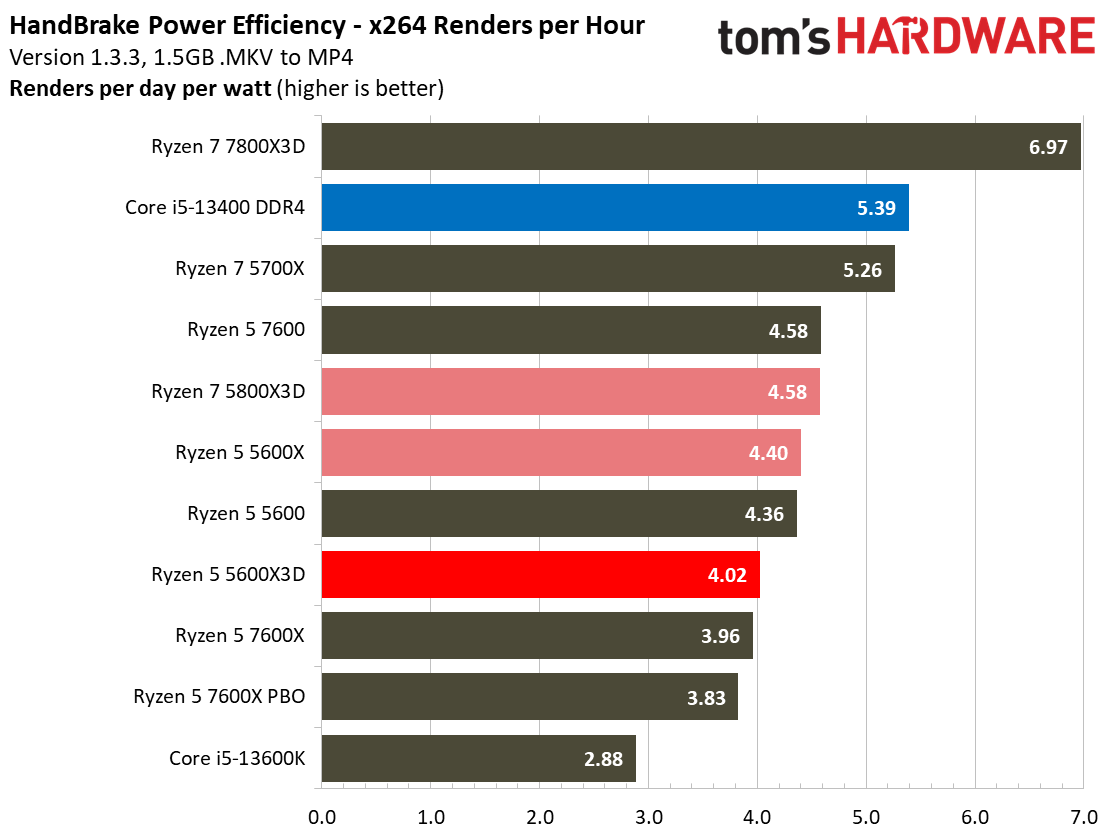

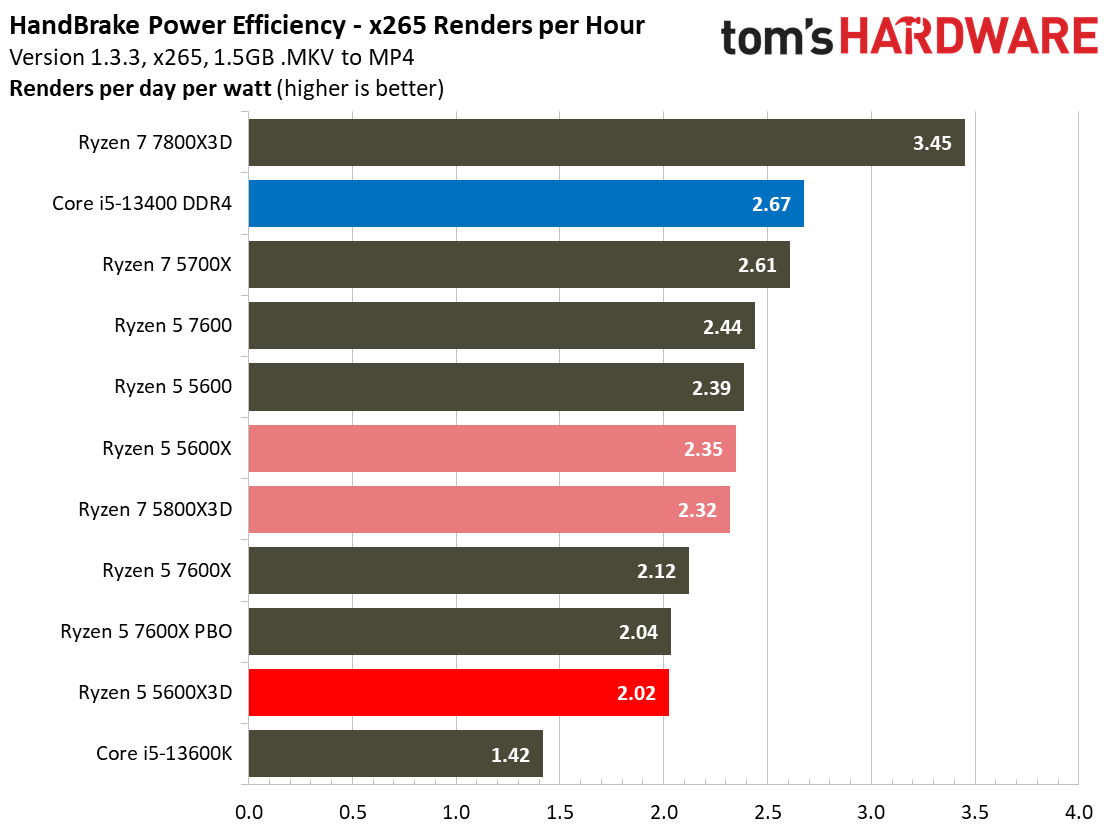
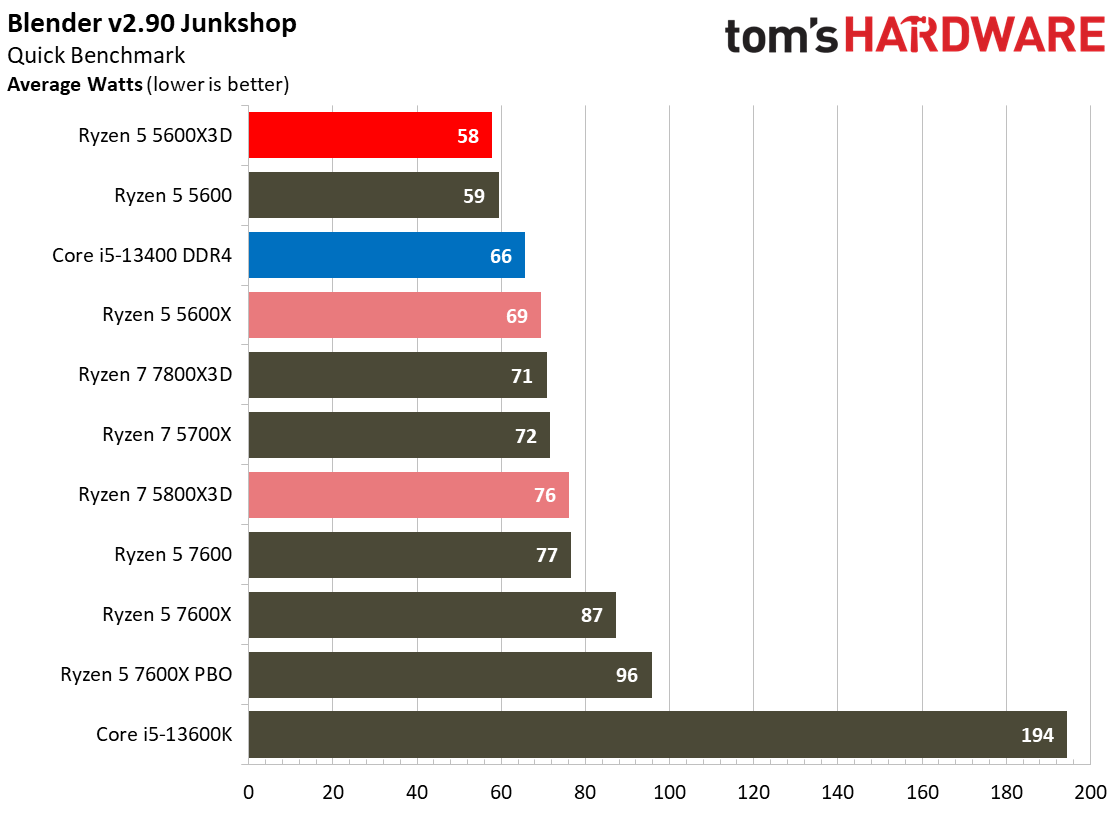
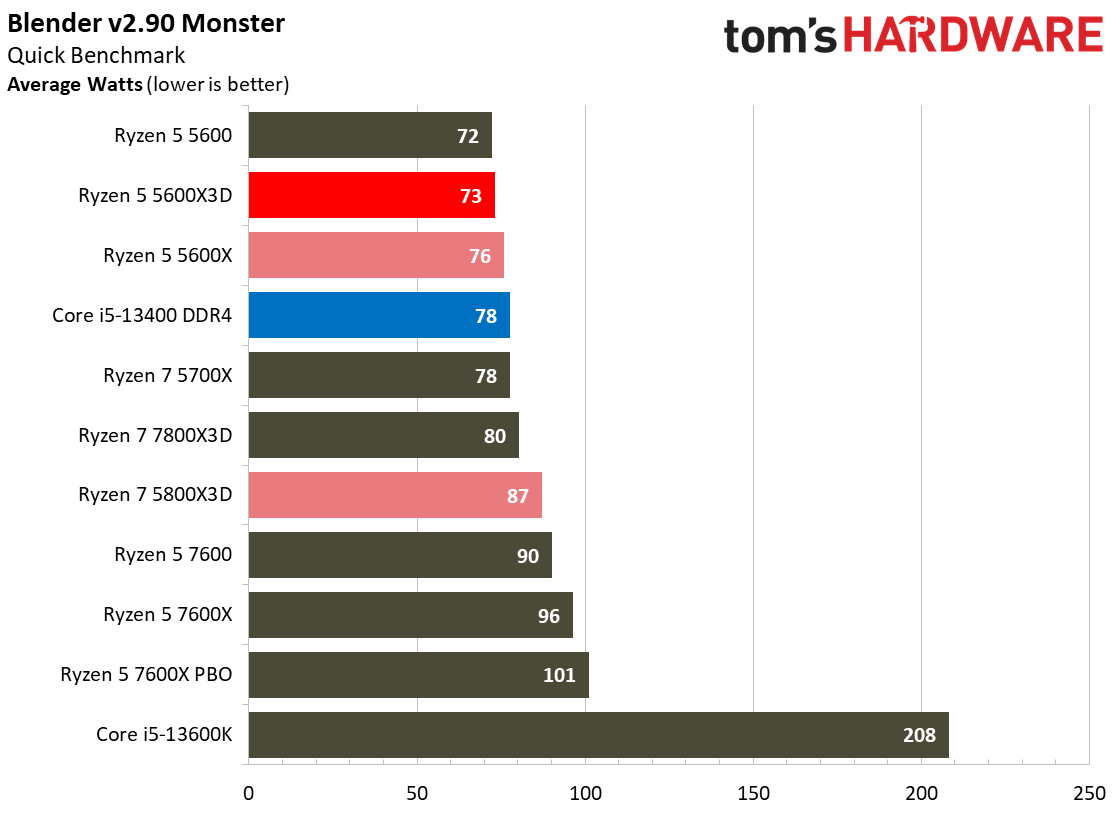
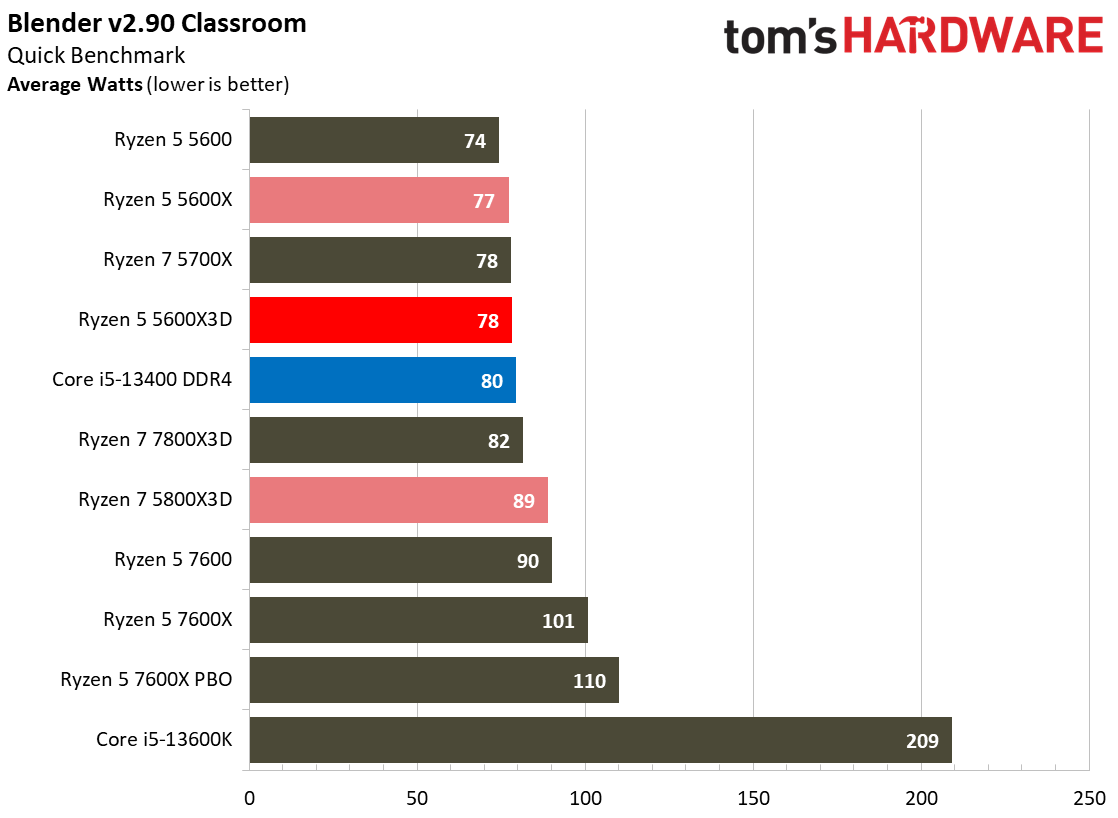
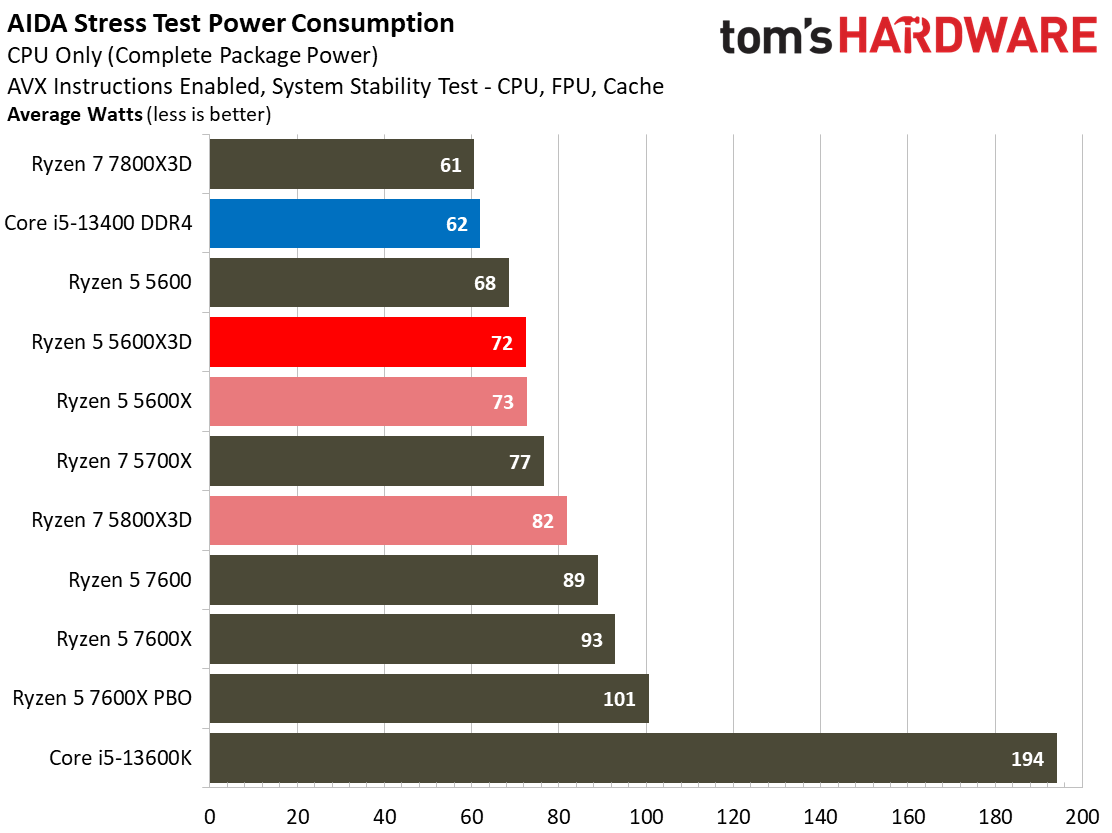
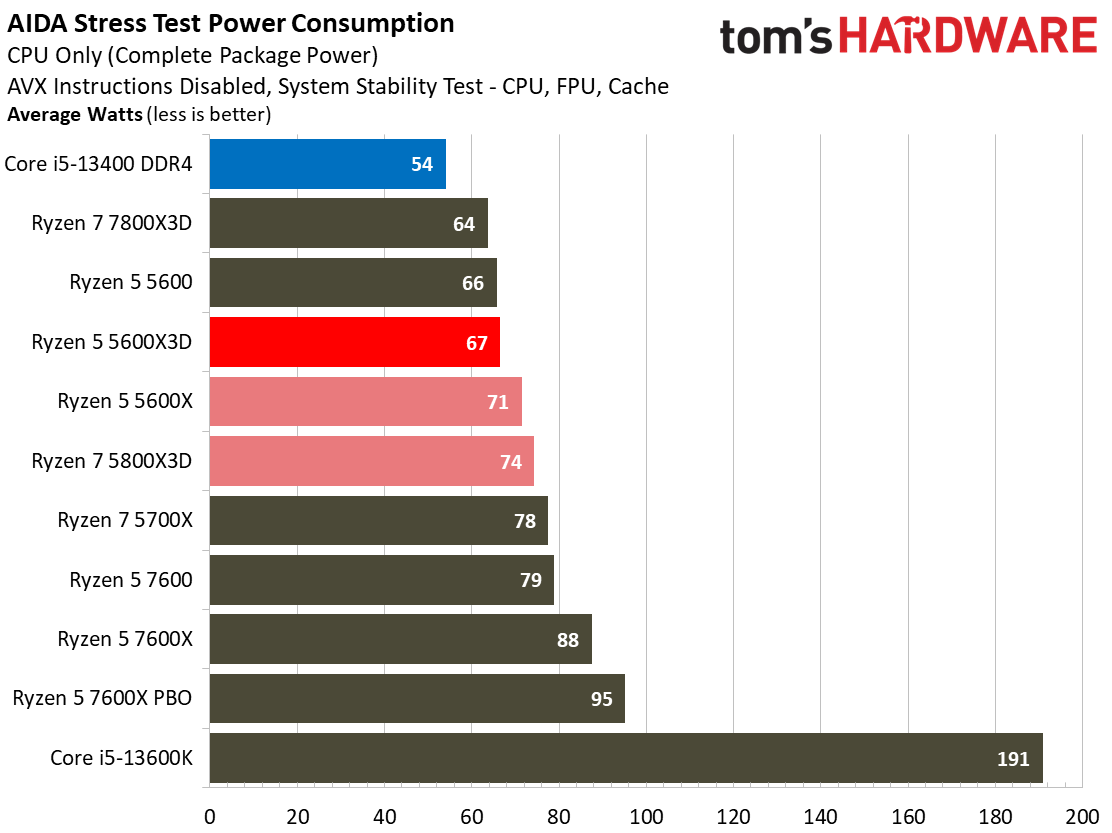
The six-core Ryzen 5 5600X3D comes with a 105W TDP rating that outstrips the 65W ratings for most of the chips in the test pool, including the eight-core Ryzen 7 5700X. In some cases, that results in the six-core Ryzen 5 5600X3D pulling more power than the 65W six-core Ryzen 5 5600X despite the former's lower boost clock rates, as evidenced by the HandBrake x264 workload. Here, the 5600X3D is actually slightly faster than the 5600X, but the higher power consumption results in a loss in the x264 renders-per-day efficiency metric.
The Ryzen 5 5600X3D's performance generally lags the rest of the test pool, so it scores poor marks in the efficiency metrics. The 5600X3D also draws more power and is less efficient than the Core i5-13400 in several workloads.
Some of the poor power efficiency stems from the higher TDP paired with the chips' comparatively lower performance, but we also know that most motherboard vendors haven't tuned for the 5600X3D because it was effectively a canceled processor. Instead, it only has a basic level of enablement.


Here we take a slightly different look at power consumption by calculating the cumulative energy required to perform x264 and x265 HandBrake workloads, respectively. We plot this 'task energy' value in Kilojoules on the left side of the chart for the Y-axis, with time taken as the X-axis.
These workloads are comprised of a fixed amount of work, so we can plot the task energy against the time required to finish the job, thus generating a really useful power chart. Bear in mind that faster compute times and lower task energy requirements are ideal. That means processors that fall the closest to the bottom left corner of the chart are the best, in terms of efficiency.
As you would expect, given the prior efficiency results, the Ryzen 5 5600X3D's power consumption-vs-performance isn't as desirable as the other 7nm Zen 3-powered Ryzen 5000 processors, and it trails the 5nm Zen 4 Ryzen 7000 chips by an even larger margin.
AMD Ryzen 5 5600X3D Test Setup and Overclocking
We're told that motherboard vendors have only enabled basic support for the Ryzen 5 5600X3D but didn't have samples to fine-tune the BIOS. As such, performance could vary with different motherboards quite a bit. As mentioned, the Ryzen 5 5600X3D doesn't support overclocking via the CPU multiplier, so you can't change the core clocks via that method. You also cannot adjust the power limits (PPT, TDC, EDC) or CPU voltage. Additionally, the chip doesn't support the auto-overclocking Precision Boost Overdrive (PBO) feature, and you can't undervolt or underclock.
The 5600X3D fully supports overclocking the memory and Infinity Fabric, but we could only reach DDR4-3600 with the fabric dialed in at 1800 MHz. This setting allows us to run the memory in the desired low-latency 'coupled' (1:1 ratio) mode. You can get higher with uncoupled memory, but that results in less performance in games. We gained less than 1% in gaming performance from overclocking the memory, and have had similar results with other X3D processors.
Several motherboard vendors offer custom overclocking options for the Ryzen 5000X3D processors, but these do come with an outsized level of risk, even for overclocking — AMD has prevented these chips from all forms of overclocking due to the limitations of the cache chiplet. The 5600X3D is truly a limited edition chip, so we chose not to risk losing our only irreplaceable sample by testing the ad-hoc overclocking methods for 5000X3D chips.
We test Intel processors with the power limits fully removed for our standard measurements, so those chips run beyond the 'recommended' power settings but remain within warranty. We used DDR4 memory for testing, as DDR5's pricing premium isn't as suitable for this class of chip.
Microsoft has advised gamers to disable several security features to boost gaming performance. As such, we disabled secure boot, virtualization support, and fTPM/PTT on all systems for maximum performance. You can find further hardware details in the table below.
We tested the Ryzen 5 5600X3D in two configurations:
- Ryzen 5 5600X3D: Corsair H115i 280mm water cooler, default power limits, DDR4-3200 in Coupled mode
Ryzen 5 5600X3D DDR4-3600: Corsair H115i 280mm water cooler, default power limits, DDR4-3600 in Coupled mode
| Intel Socket 1700 DDR5 (Z790) | Core i7-13700K, Core i5-13600K, Core i5-13400 |
| Motherboard | MSI MAG Z790 Tomahawk WiFi |
| RAM | 2x 8GB Trident Z Royal DDR4-3600 - Stock: DDR4-3200 14-14-14-36 / OC: DDR4-3600 |
| AMD Socket AM4 (X570) | Ryzen 5 5600X3D, Ryzen 7 5800X3D, Ryzen 7 5700X, Ryzen 5 5600X, Ryzen 5 5600 |
| Motherboard | MSI MEG X570 Godlike |
| RAM | 2x 8GB Trident Z Royal DDR4-3600 - Stock: DDR4-3200 | OC/PBO: DDR4-3800 |
| AMD Socket AM5 (X670E) | Ryzen 7 7800X3D, Ryzen 5 7600X, Ryzen 5 7600 |
| Motherboard | ASRock X670E Taichi |
| RAM | G.Skill Trident Z5 Neo DDR5-6000 - Stock: DDR5-5200 | OC/PBO: DDR5-6000 |
| All Systems | 2TB Sabrent Rocket 4 Plus, Silverstone ST1100-TI, Open Benchtable, Arctic MX-4 TIM, Windows 11 Pro |
| Gaming GPU | Asus RTX 4090 ROG Strix OC |
| Application GPU | Nvidia GeForce RTX 2080 Ti FE |
| Cooling | Corsair H150i, Stock Cooler |
| Overclocking note | All configurations with overclocked memory also have tuned core frequencies and/or lifted power limits. |
Get Tom's Hardware's best news and in-depth reviews, straight to your inbox.
Current page: AMD Ryzen 5 5600X3D: Power Consumption, Efficiency, Test Setup, Overclocking
Prev Page AMD Ryzen 5 5600X3D Productivity Benchmarks Next Page Get It While You Can
Paul Alcorn is the Editor-in-Chief for Tom's Hardware US. He also writes news and reviews on CPUs, storage, and enterprise hardware.
-
-Fran- Should we start calling the X3D parts "game accelerators"? Heh.Reply
Thanks for the benchies as well!
Quite the good value for a platform that, quite simply, refuses to die. If there's people that has access to the 5600X3D and was trying to hold out for AM5, well, this CPU may just give them a few more years of not needing an upgrade at all? Maybe?
It also makes a compelling argument for a cheap new budget build, but I would still spend the few extra macarroons and get the R5-7600 in AM5 and wait for later AM5 CPUs.
Regards. -
King_V Welp, last year (February), I succumbed to a great deal and made an hour-long drive to Micro Center to upgrade from a Haswell system to a 5600X with A520M motherboard.Reply
It's seen less use than I had originally planned.
That all said, had I been a little more patient, and realized at the time that I wouldn't be having that much use, this combo would definitely have been where I said "let me plan my drive to Micro Center," and with the price of SSDs going down, probably wouldn't have cost me much more than my current system.
Still, I don't regret my 5600X. -
healthy Pro-teen At least for non-US users, 5700X provides comparable performance if you don't have a 4090/4080 or such (probably step up to AM5 if you spend that much on GPUs). I think AMD doesn't have enough cut down 5800X3D dies to justify a global launch.Reply -
Co BIY Replyoofdragon said:Just to remember, they are not making these chips but recycling defective 5800X3D, so the exclusivety is due to really having little to sell.
From the article: "sources close to the matter tell us these chips were “purpose-built” to be launched as Ryzen 5 5600X3D parts. As such, they aren’t made of defective Ryzen 7 5800X3D processors."
I wonder if the design tools and processes that allow for flexible SOCs and such are also allowing much more flexibility in processor production.
With the RTX 4060 that this class of chips is most likely going to be paired with I doubt there is any observable difference in performance between any of the chips. (this would be a worthwhile test). -
Avro Arrow Reply
Looking at the performance available, they were stupid not to produce it in the first place. I said the same thing about their lack of an R5-7600X3D.healthy Pro-teen said:At least for non-US users, 5700X provides comparable performance if you don't have a 4090/4080 or such (probably step up to AM5 if you spend that much on GPUs). I think AMD doesn't have enough cut down 5800X3D dies to justify a global launch. -
TJ Hooker Reply
X3D chips are just normal CCDs (core chiplet dice) with a separate SRAM die added on top. I would imagine they've had the capability to produce them as lower core count products since day one, in the same way they produce lower core count non-X3D parts (as they use the same CCDs).Co BIY said:I wonder if the design tools and processes that allow for flexible SOCs and such are also allowing much more flexibility in processor production. -
TJ Hooker Reply
I'm guessing it comes down to margins. So long as yields are good, making an 8 core CPU doesn't really cost them any more than a 6 core CPU, but they can charge more for it. At that point it doesn't make sense to release the 6 core part so long as you're still selling all the 8 core parts you can make reasonably quickly.Avro Arrow said:Looking at the performance available, they were stupid not to produce it in the first place. I said the same thing about their lack of an R5-7600X3D.
Edit: Although I guess the same could be said about non-X3D 8 vs 6 core chips as well. I'm not sure why it made sense to release 6 and 8 core simultaneously for non-X3D, but not for X3D. I still suspect they did so as a result of business considerations though, rather than not understanding that 6 core X3D CPUs would be viable products. -
Dr3ams In a few years or so an unboxed 5600X3D will be a collectors item, sold on Ebay for a disgusting amount of money.Reply
